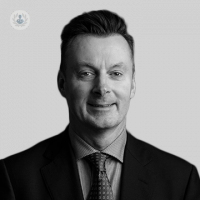What is a chordoma?
Escrito por:A tumour is a scary prospect wherever it is on the body, but even more so in an area as sensitive as the nervous system. The spine and skull base are vulnerable to certain cancers. Expert neurosurgeon Mr Nicholas Thomas is here to talk about one rare type – chordoma.

A chordoma is a rare tumour, affecting around one in a million people per year (according to the Chordoma Foundation). Occurring in the spine and skull base, they are thought to develop from cells left over from the notochord – a structure found in developing embryos that aids the development of the spine, which disappears as the bones of the spine grow. A small amount of notochord cells are left behind in the spine and skull base, which, in rare cases, turn cancerous, resulting in a chordoma.
Most chordoma cases are diagnosed in patients aged 50 and over, but they have been known to affect people of all ages. Chordomas can develop anywhere along the spine, but are most commonly found in the sacrum.
Symptoms of chordoma
Chordoma symptoms depend on the location of the tumour. If the chordoma is in the spine, symptoms can include:
- Pain and/or numbness
- Back pain which radiates to other body parts
- Loss of balance, feeling unsteady
- Difficulty walking
- Changes or problems in bladder and bowel movements
- Pain that gets worse at night
If the tumour is in the skull, symptoms can include:
- Headache
- Pain, tingling, or numbness in the face
- Dizziness/unsteadiness
- Double vision
- Changes in hearing
What causes chordomas?
It is not known why chordomas develop. It is extremely rare for it to run in families, with only a handful of cases where multiple members of the same family have had a chordoma. Similarly, no environmental or lifestyle factors have been identified. Research into the causes of chordomas is ongoing.
Diagnosis
Chordomas can be easily mistaken for other tumours, such as schwannomas. For this reason, it’s important to consult an experienced specialist consultant neurosurgeon or neurologist when experiencing symptoms to make sure you get the right diagnosis.
After analysing the symptoms and medical history, the doctor will order an MRI scan, which is the best way to diagnose a chordoma, showing the tumour and how it is affecting the surrounding tissue. A CT scan may also be carried out if further details are needed.
A biopsy may also be taken, depending on the tumour’s position. This is where a sample of the tumour is removed and analysed under a microscope. This will give a definitive diagnosis.
Treatment
Chordoma treatment can vary depending on the size and position of the tumour and on the age and general health of the patient.
If the chordoma is small or slow-growing and isn’t causing pressure or damage to the surrounding tissue, the doctor may recommend simply watching and waiting, with regular scans and reviews to monitor the tumour.
Surgery to remove the chordoma can be the most effective way of treating the cancer; however, due to its position in the central nervous system, surgery can be risky. Depending on the location, the tumour may be inoperable, or only part of it may be able to be removed as removing the whole thing would be more dangerous than leaving part of it.
In such cases, radiotherapy and chemotherapy are options that kill cancer cells using beams of radiation and powerful drugs respectively. Both can have significant side-effects.
All treatment options have their benefits and risks of complications, so it is imperative that the everything is fully explained to the patient so that they can make an informed decision and understand what is happening and why every step of the way.
If you have been diagnosed with a chordoma and want to discuss your treatment options, or if you are displaying symptoms and would like a consultation, visit Mr Thomas’s Top Doctors profile and book an appointment.


